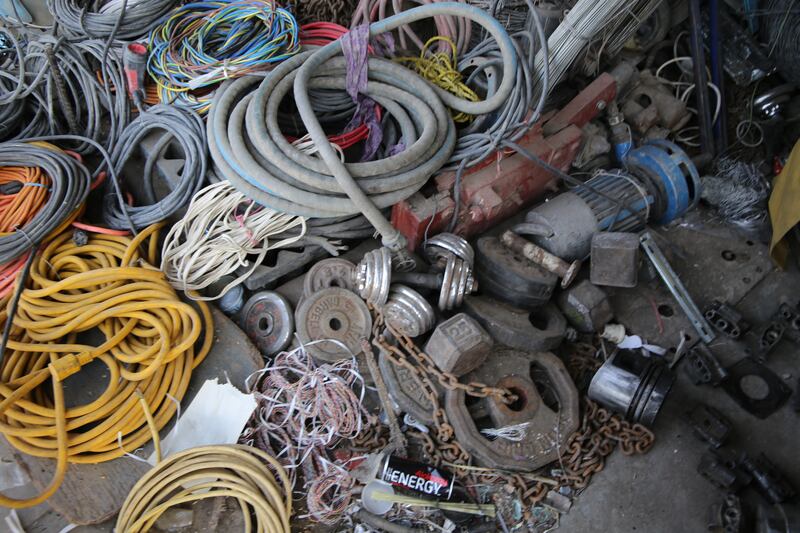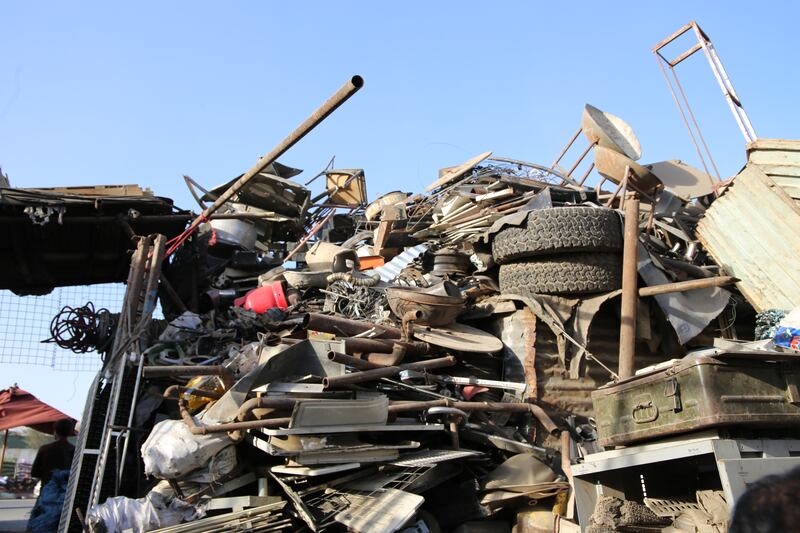KABUL—“I was once the commander of guards at a NATO base,” Mohammed Salem tells The Daily Beast as he prepares a lukewarm cup of chai. He is sitting on a dirty and tattered rug on the streets in a rundown bazaar in central Kabul. “Now, we are here.”
There’s no anger in his voice, only a hint of sadness and regret.
When he stands to introduce himself, his back is straight, and he speaks as if he was still barking orders to his troops. His immaculately clean white robes and confidence are a stark contrast to the poverty of the scene around him. Behind him is a scrap metal junkyard and on the other side of the road are stalls where people in Kabul are selling their family furniture and clothing to make ends meet.
Like many Afghans, the crumbling economy has reduced Salem to destitution. He is just one of the estimated tens of thousands of Afghans who risked his life to help the U.S.-led war effort in Afghanistan, but remains trapped in the country. He wanted his story to be told so that the world would not forget who was left behind.
Salem worked helping the U.S. and its allies provide security for a variety of NATO bases throughout Kabul, including the headquarters of Operation Resolute Support in Kabul, one of many command centers for a military occupation spanning nearly twenty years. It hosted dignitaries like John Kerry and James Mattis, who would take photo ops with U.S. forces. At one of these visits in 2017, Mattis told reporters he condemned the Taliban for the bombing of an Afghan army base saying: “We stand with the people of this country against such heinous acts perpetrated by this barbaric enemy.”
Now the headquarters, like other foreign bases in the country, lies empty after being abandoned overnight. The Taliban flags flying over its ramparts are the surest of signs to people like Salem they have been left to fend for themselves.

“I worked with countries from around the world like the United States and Germany. I have a letter from my American commander thanking me for my service. He was my colleague and my friend. Now they have fled and abandoned us here,” says Salem. He explained that he tried to track down his former American colleagues but was unable to make any contact with them. “I tried emailing but the address that they gave me didn’t work.
Salem corroborated his four-year service history by providing The Daily Beast with a dozen documents, including his photo identity badge and a letter of recommendation from his former supervisor. When contacted by The Daily Beast, his supervisor asked not to be named but said that “there were no official plans for evacuating local national staff that I was aware of.”
NATO’s press office did not reply to The Daily Beast’s requests for comment. Like many Afghans who worked in these positions, Salem was hired by a contractor who in turn was funded by USAID. When contacted about Salem’s story, USAID referred The Daily Beast to the State Department. When reached, a State Department spokesperson did not not comment directly on Salem’s situation, instead writing that it is “accelerating processing for qualified Afghan Special Immigrant Visa applicants” with instructions on how to apply.
But Salem’s story illustrates a significant flaw in the Special Immigrant Visa system and plans to evacuate U.S. allies. The process was byzantine even for Afghans fluent in English, who could navigate the digital application process. For someone like Salem, who struggles with the language and has few digital skills, it is almost impossible.
Taliban leaders across the country insist that they are offering general amnesty to anyone who worked with U.S. forces, but the extent to which this amnesty is real is still debated. Foreign Policy reported that the Taliban had carried out raids in Kabul searching for people who had been working with foreign governments.

Still, many Afghans told The Daily Beast they were less concerned about this than they were about the collapsing economy. They believe that even if they are not hunted down, their service with the previous regime will be a black mark that prevents them from ever finding employment.
“The economic situation here is horrible. All of us are now jobless,” Mohammad’s former colleague Sadique, who also sells tea on the streets of Mahmoud Khan, told The Daily Beast. “We are starving and there are people starting to die from hunger.” Sadique said he used to be in the ‘military’ but did not want to give further details or his last name.
The past few months have been a perfect storm. After the militant group took over Afghanistan, the foreign staff of most international aid organizations left the country along with many of their most skilled Afghan employees. Those NGO staff who want to come back have limited options, because there are still few flights in or out of the country. The former government of Afghanistan was heavily reliant on foreign assistance, and that has almost completely dried up. The banking system is frozen because of international sanctions on the Taliban, and getting money into Afghanistan remains extremely difficult.
The United Nations has warned of an impending catastrophe as the country heads into winter. A recent report said that as many as 97 percent of the country’s population could fall below the poverty line. It would then replace Yemen as the world’s worst humanitarian disaster. In one camp for internally displaced people, Abdul Jalil, a representative of displaced people from Parwan province, told The Daily Beast they had not seen any assistance from international organizations or the new government in the three months they had been there. The only people to deliver them supplies had been a local Afghan food and beverages company. He said the international community had no choice but to engage with Afghanistan’s new rulers. For them, it was a matter of life or death.

A common refrain from Afghans bewildered by the abrupt U.S. departure is: “We don’t know why they came here, and we don’t know why they left.”
One former translator for American forces who preferred to stay anonymous told The Daily Beast: “[The U.S.] was here for so long, they spent so much money and so much time and so many people died. Why did they want to leave before the job was done? I’m not even angry anymore, but I just want to understand why our country turned out like this.”
Surprisingly, Salem says he feels nostalgic for his time working with the West. “I liked the Americans being here and I wished they had stayed. Things were better than they will be in the future. I think it was the first time they got to learn about Islam and build connections between Muslims and your countries. Them leaving like they did was a terrible thing for Afghanistan.”
Sadiq breaks in to disagree. “No, I think the Americans were nothing but cruel to the people here.” He’s even more pessimistic about the future of Afghanistan, pointing to recent explosions attributed to Islamic State’s Khorasan province in Kabul Kandahar and Kunduz that killed scores of civilians. Just this week, another suspected ISIS attack on a hospital in Kabul killed at least 25 people and left dozens injured.
It seems many citizens voice similar sentiments now. “You shouldn’t come here with your cameras anymore,” said Masoud, an Afghan at a small furniture stall down the street from where Salem was working. “The reason we Afghans live like this is because you foreigners came here. It’s because of you that we have nothing left.”
Yet Salem is sanguine about his own fate. “I still have my religion and my health for now,” he told The Daily Beast. “So I have reasons to be happy.”



